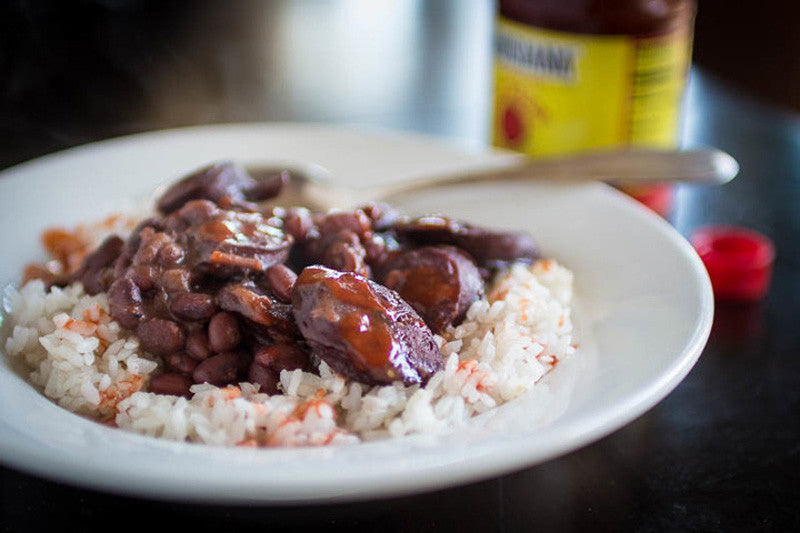
It’s easy to get obsessed about New Orleans Red Beans and Rice. It’s a delicious dish with a mythic story. I’ve had many great versions, and even more bad ones.
The iconic New Orleans dish was made to be slow cooked on a Monday, using Sunday night’s ham bone. It needs to be a somewhat easy, one pot dish to cook in the background as you tend to the chore of washing on Monday. The dish was born out of economy, both for time and the cost of ingredients. It needs to be fabulous.
Most traditional recipes will call for the ham bone and sometimes more ham, cubed. Virtually all of them call for andouille sausage, a smoked, coarse-grind sausage. Hot links, even Louisiana hot links, are not the same thing, even though they’re smoked. They’re made with a finer grind and the texture is wrong. Andouille are smoked, and therefore already cooked, so the long slow cooking with the beans is for adding flavor, not to cook the sausage. They aren’t subtle.
The spice level is all over the map. I love my heat but I prefer it at the end in the form of a vinegary hot sauce like Tabasco, Crystal or Louisiana. In fact, even though it’s added by each diner as the dish is being served, I would include hot sauce as another essential part of the dish.
Personally, my biggest challenge was the broth. How soupy? How thin? In the end, I thought of it more as gravy. It should be thin enough to coat each grain of rice and dense enough to cling. A lot of cooks get this perfect texture by mashing some of the beans and then mixing them back into the pot. I prefer even longer cooking. You can do this in a few hours but my preference is to keep it low and let it go most of the day, mostly undisturbed.
We have to mention the beans, of course. Traditionally one uses a Louisiana brand of red kidney beans. They are great. I, of course, needed to experiment with our Domingo Rojo red beans. I think the Domingo Rojo are perfect for this dish. They hold their shape well, even after hours of cooking and as they break down, they release the dreamiest of sauces, perfect for caressing the white rice. You can cook red beans and rice in a couple of hours with a steady simmer. I prefer to start in the morning and let the pot evolve on a low heat, almost neglected.
I am biased, naturally, but when you have good heirlooms, a ham hock and ham are almost too much and unwanted. I say this as a lover of pork. The sausage with the beans is just about perfection. Save the ham bone for a pea soup or some other project.
There is a magical moment when it’s done. You should be able to taste a spoonful of the broth and if you’re anything like me, you realize you’re not going to be able to stop with one small taste. It’s so good!
If you want to dig deeper, I can suggest Donald Link’s Down South and Kim Severson’s version (inspired by Pableaux Johnson) in the New York Times.
- 1 pound Rancho Gordo Domingo Rojo beans, or Mayan Red beans uncooked
- 2 tablespoons oil
- 1 to 1 1/2 pounds Andouille sausage, cut into thick slices
- 2 yellow onions, chopped
- 5 cloves garlic, chopped
- 1 rib celery, sliced
- 2 green bell peppers, seeds and pith removed, chopped
- 4 bay leaves
- 1 teaspoon cayenne pepper, ground
- 1 tablespoon dried thyme
- Pepper
- Salt
- 1 tablespoon Creole mustard (or coarse grain mustard
- Vinegary hot sauce like Louisiana, Crystal or Tabasco, for serving
- White, long grain rice, cooked, for serving
- In a large pot, such as an enameled cast iron dutch oven, heat the oil over medium heat and brown the sausage slices, stirring occasionally, about 6 minutes. Remove and reserve the sausage. Add the onion, garlic, bell pepper and celery and saute until soft, stirring occasionally, about 10 minutes.
- Add the dry beans, bay leaves, thyme, cayenne and enough water to cover by about 2 inches. Bring to a strong boil and continue boiling for 15 minutes. Reduce heat to low to medium low, so that the beans are cooking with a gentle simmer.
- Once the beans have started to soften but not cooked fully, just over an hour, add the reserved sausage to the beans along with the mustard. Continue to cook until the beans are soft. Add more water as needed. If you’re pressed for time, once the beans are cooked, you mash some against the side of pot with a wooden spoon to thicken the liquid, or continue cooking until the liquid is more like a thick gravy than a thin soup.
- Check for seasoning and salt and pepper to taste. Serve with plain rice and bottles of hot sauce.

